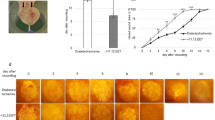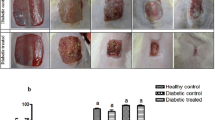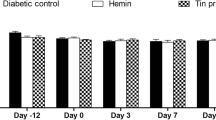Abstract
This study was done to analyze the effect of selenium on antioxidant status and expression of different connexins in diabetic wound healing. The levels of vascular endothelial growth factor, superoxide dismutase, lipid peroxide, and connexins were analyzed in wound tissues taken from diabetic and non-diabetic mice before and after sodium selenite administration. The mRNA transcript levels of Cx 26, 30.3, 31, 31.1, and 43 were significantly elevated in diabetic wounds as compared to the non-diabetic wounds. After selenium administration, the expression of connexins along with serum glucose decreases more significantly in diabetic wounds as compared to non-diabetic wounds. In diabetic wounds, the low levels of vascular endothelial growth factor and extracellular superoxide dismutase were restored to normal level following selenium administration. The lipid peroxidation decreased significantly in diabetic mice post-selenium administration. The histopathological analysis revealed that administration of selenium improves angiogenesis at the wound site. The results of this study demonstrate that selenium, acting as an essential component of the antioxidant system, normalizes the antioxidant status, and as an insulin mimetic compound, downregulates connexin expressions and induces angiogenesis. Together, these effects of selenium accelerate wound healing in diabetic conditions.





Similar content being viewed by others
References
Wild S, Roglic G, Green A, Sicree R, King H (2004) Global prevalence of diabetes: estimates for the year 2000 and projections for 2030. Diab Care 27:1047–1053
Bajpai S, Shukla VK, Tripathi K, Srikishna S, Singh RK (2009) Targeting connexin 43 in diabetic wound healing: future perspectives. J Post Grad Med 55:143–149
Brem H, Tomic-Canic M (2007) Cellular and molecular basis of wound healing in diabetes. J Clin Invest 117:1219–1222
Vijay SK, Mishra M, Kumar H, Tripathi K (2009) Effect of pioglitazone and rosiglitazone on mediators of endothelial dysfunction, markers of angiogenesis and inflammatory cytokines in type-2 diabetes. Acta Diabetol 46:27–33
Wang CM, Lincoln J, Cook JE, Becker DL (2007) Abnormal connexin expression underlies delayed wound healing in diabetic skin. Diabetes 56:2809–2817
Wei CJ, Xu X, Lo CW (2004) Connexins and cell signaling in development and disease. Annu Rev Cell Dev Biol 20:811–838
Qiu C, Coutinho P, Frank S, Franke S, Law LY, Martin P, Green CR, Becker DL (2003) Targetting connexin 43 expression accelerates the rate of wound repair. Curr Biol 13:1697–1703
Ramachandran S, Xie LH, John SA, Subramaniam S, Lal R (2007) A novel role for connexin hemichannel in oxidative stress and smoking-induced cell injury. PLoS ONE e712:1–12
Kalvelyte A, Imbrasaite A, Bukauskiene A, Verselis VK, Bukauskas FF (2003) Connexins and apoptotic transformation. Biochem Pharmacol 66:1661–1672
Oviedo-Orta E, Howard Evans W (2002) Gap junctions and connexins: potential contributors to immunological synapse. Leukoe Biol 72:636–642
Vinken M, Vanhaecke T, Papeleu P, Snykers S, Henkens T, Rogiers V (2006) Connexins and their channels in cell growth and cell death. Cell Signal 18:592–600
Galiano RD, Tepper OM, Pelo CR, Bhatt KA, Challaghan M, Bastidas N, Bunting S, Steinmetz HG, Gurtner GC (2004) Topical vascular endothelial growth factor accelerates diabetic wound healing through increased angiogenesis and by mobilizing and recruiting bone marrow-derived cells. Am J Pathol 164:1935–1947
Witte MB, Kiyama T, Barbul A (2002) Nitric oxide enhances experimental wound healing in diabetes. Br J Surg 89:1594–1601
Stapleton SR (2000) Selenium: an insulin-mimetic. Cell Mol Life Sci 57:1874–1879
Rotruck JT, Pope AL, Ganther HE, Swanson AB, Hafeman DG, Hoekstra WG (1973) Selenium: biochemical role as a component of glutathione peroxidase. Science 179:588–590
Lee SR, Bar-Noy S, Kwon J, Levine RL, Stadtman TC, Rhee SG (2000) Mammalian thioredoxin reductase: oxidation of the C-terminal cysteine/selenocysteine active site forms a thioselenide, and replacement of selenium with sulfur markedly reduces catalytic activity. Proc Natl Acad Sci 97:2521–2526
Yeo JE, Kim JH, Kang SK (2008) Selenium attenuates ROS-mediated apoptotic cell death of injured spinal cord through prevention of mitochondria dysfunction; in vitro and in vivo study. Cell Physiol Biochem 21:225–238
Wood SC, Rao TD, Frey AB (1999) Multidose streptozotocin induction of diabetes in BALB/cBy mice induces a T cell proliferation defect in thymocytes which is reversible by interleukin-4. Cell Immunol 192:1–12
Ohkawa H, Ohishi N, Yagi K (1979) Assay for lipid peroxides in animal tissues thiobarbituric acid reaction. Anal Biochem 95:351–358
Misra HP, Fridovich I (1972) The role of superoxide anion in the autoxidation of epinephrine and a simple assay for superoxide dismutase. J Biol Chem 247:3170–3175
Fonseca PC, Nihei OK, Urban-Maldonado M, Abreu S, Campos de Carvalho AC, Spray DC, Savino W, Alves LA (2004) Characterization of connexin 30.3 and 43 in thymocytes. Immunol Lett 94:65–75
Mishra M, Kumar H, Pokharia D, Arya AK, Bajpai S, Singh RK, Rai M, Tripathi K (2009) Effect of pioglitazone, rosiglitazone and glipizide on NOx, TNF-α, VEGF, angiogenin in type 2 diabetes mellitus with cardiovascular complications. Diabetes 58(suppl1):A131–A131
Mishra M, Kumar H, Tripathi K (2008) Diabetic delayed wound healing and the role of silver nanoparticles. Dig J Nanomater Bios 3:49–54
Bajpai S, Mishra M, Kumar H, Tripathi K, Singh SK, Srikishna S, Pandey HP, Singh RK (2010) Comparative study of connexins expression in diabetic and non diabetic wounds. Dig J Nanomater Bios 5:857–862
McNeill JH, Delgatty HL, Battell ML (1991) Insulin like effects of sodium selenate in streptozocin-induced diabetic rats. Diabetes Care 40:1675–1678
Rakotovao A, Tanguy S, Toufektsian MC, Berthonneche C, Ducros V, Tosaki A, de Leiris J, Boucher F (2005) Selenium status as determinant of connexin-43 dephosphorylation in ex vivo ischemic/reperfused rat myocardium. J Trace Elem Med Biol 19:43–47
Hei YJ, Farahbakhshian S, Chen X, Battell ML, McNeill JH (1998) Stimulation of MAP kinase and S6 kinase by vanadium and selenium in rat adipocytes. Mol Cell Biochem 178:367–375
Baynes JW (1991) Role of oxidative stress in development of complications in diabetes. Diabetes 40:405–412
Rajasekaran NS, Nithya M, Rose C, Chandra TS (2004) The effect of finger millet feeding on early responses during the process of wound healing in diabetic rats. Biochim Biophys Acta 1689:190–201
Mukherjee B, Anbazhagan S, Roy A, Ghosh R, Chatterjee M (1998) Novel implications of the potential role of selenium on antioxidant status in streptozotocin-induced diabetic mice. Biomed Pharmacother 52:89–95
Papp LV, Lu J, Holmgren A, Khanna KK (2007) From selenium to selenoproteins: synthesis, identity, and their role in human health. Antioxid Redox Signal 9:775–806
Goliger JA, Paul DL (1995) Wounding alters epidermal connexin expression and gap junction mediated inter cellular communication. Mol Biol Cell 6:1491–1501
Cautinho P, Qiu C, Frank S, Tamber K, Becker DL (2003) Dynamic changes in connexin expression correlate with key events in the wound healing process. Cell Bio Int 27:525–541
Suarez S, Ballmer-Hofer K (2001) VEGF transiently disrupts gap junctional communication in endothelial cells. J Cell Sci 114:1229–1235
Acknowledgement
We are thankful to Dr. Luiz Anastacio Alves, Department of Immunology, Oswaldo Cruz Institute, Brazil for his kind consent to use primers. The financial assistance extended by Banaras Hindu University is greatly acknowledged. S. Bajpai is highly thankful to C.S.I.R. for providing senior research fellowship (S.R.F.). Authors M. Mishra and H. Kumar are thankful to UGC for financial support as Dr. D.S. Kothari Postdoctoral fellowship {4-2/2006(BSR)/13-334/2010(BSR)} and S.R.F., respectively.
Author information
Authors and Affiliations
Corresponding author
Additional information
Surabhi Bajpai and Manish Mishra contributed equally for this study.
Rights and permissions
About this article
Cite this article
Bajpai, S., Mishra, M., Kumar, H. et al. Effect of Selenium on Connexin Expression, Angiogenesis, and Antioxidant Status in Diabetic Wound Healing. Biol Trace Elem Res 144, 327–338 (2011). https://doi.org/10.1007/s12011-011-9097-7
Received:
Accepted:
Published:
Issue Date:
DOI: https://doi.org/10.1007/s12011-011-9097-7




